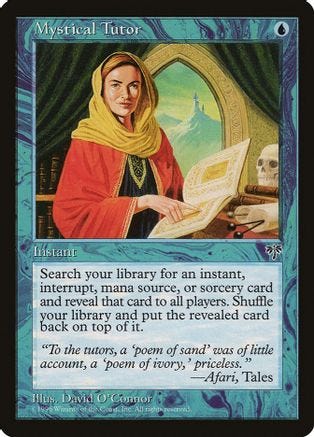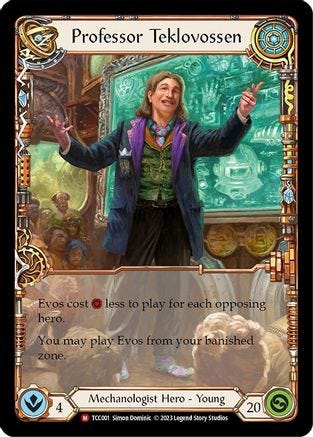Whenever a new TCG launches, or a new set in an established game is released, you can imagine the amount of newcomers that flock to that game. These people include experienced TCG vets looking for a new squeeze, as well as players completely new to the genre.
Anytime we have new players, we need teachers. Like anyone who has ever been to school can tell you, there are good teachers and there are terrible teachers. Good teachers can spur your interest in a subject that launches you into the career you’ll have the rest of your life. Terrible teachers can leave you disinterested, afraid, or even loathsome of their discipline. For example, I would love to learn to draw. My middle school art teacher, however, thought it was a good idea to tell me I was terrible at it and not try. Now in my 30s, I still hesitate to give it a go. I think there’s an empty sketchbook and a charcoal pencil somewhere in my office.
So it’s imperative, therefore, that when you sit down to teach a friend, partner, or stranger at your LGS a new game, you approach it in a healthy way that incentivizes their experience. If you’re anything like me, you worry whether you’re good at teaching games or not. So, rather than pretend to be an expert (who am I kidding, I love the attention), I’ve taken some advice from a friend who is.
Teage Watson is a FaB judge, tournament organizer, moonlights as an LGS employee, and is an stellar friend. He might be a top 5 all-time car trip partner. Teage is passionate about getting people off to a running start in whatever game, TCG or otherwise, he’s teaching. When Teage messaged me with a suggestion for a Opossum Paper on teaching TCGs, I was hooked.
What follows is Teage’s writeup to me. At his request, I’ve edited it a bit for length and clarity, but left the tone, essence, and “Teageness” wholly intact. Most of you don’t know what Teage sounds like, but I can hear his voice as I read it. I hope you enjoy it as much as I did.
Teaching TCGs by Teage Watson
Before we get started, I think it is important to remember Tim Towtdi, the marginally clever motto/initialism adopted by Perl developers: “There is more than one way to do it.” The process of teaching a game has as much to do with the teacher as it does the game. Teaching styles of a casual player will vary quite a lot from a competitive player’s style. Those players’ goals are different. What each player values in a given game will often not align. The casual player is just trying to have a good time. The competitive player, however, is looking for optimal play, the best line, or the deck that will grab the top spot in a tournament. This difference of focus will creep in to teaching. This isn’t inherently bad, but it is important to keep in mind when teaching. I’m going to point out a few things to think about when you approach a new player wanting to (or begrudgingly agreeing to) try out your favorite game.
Teaching the Game vs. Teaching to Be Good at the Game
This comes down to the old “Crawl, Walk, Run.” At the beginning, most players will be overwhelmed by the rules, card symbols, timing windows, terminology, etc. They go from zero to understanding a whole new game system in a span of 20 minutes. Players with a TCG background may have a head start, but that is only an opportunity to truncate this initial process, not skip it entirely.
Don’t worry about having the player play optimally. If you handed the student a hyper-aggro deck, and they start defending instead of going “all gas, no brakes’, let them. Play the game. Teach the fundamental rules. After the game, talk about the deck. It’s okay if they didn’t understand the deck you gave them. It’s also okay if it’s not their preferred play style. It is largely irrelevant for the first game or two.
What we are teaching in those first two games are the rules. The mechanics of the game. The meta, playstyles of a given deck, and matchups all come later. If a player hates the resource system, turn structure, or pace of a game, then playing a deck optimally won’t matter. That first teaching game is to give the player a familiarity of the system’s bones.
Why are you, the teacher, here?
This is where a little tough love comes in. If you are here to crush your opponents, play that gotcha combo and snatch a win from your opponent, or play that deck that basically tells your opponent “nah bro, you don’t get to play”, then you need to move along. You shouldn’t be teaching games to anyone. “Stomping newbs” is not going to bring in new players. That is growing your ego, not your community.
Of course, this is not a “Let the Wookie win” scenario either. Your student already knows you are better at the game than them. That is not news to anyone. Teaching a game is walking that fine line between compassion and competition. Almost every time a new player wins a teaching game, the first thing they ask is, “You let me win that one, didn’t you?”
I recommend pulling your punches. In Flesh and Blood, this could be pitching your best card or blocking with your Pummel. In Lorcana or Star Wars Unlimited, you could lay down that power card for resources. You are not throwing the game. You’re giving your opponent a fighting chance. If the game’s demo decks are not completely balanced, or one is more straight forward, give the better one to the new player. You are not looking to win, you are looking to recruit. They are going to make bad plays and take suboptimal lines. Let them, but make a few questionable plays yourself.
Let’s Talk Deck Choice
Keep it Simple. (not gonna say the last part, that’s just hurtful). If your student likes the game, there will be plenty of time to branch out into deck of choice. The first game or two is just getting the basics. You have to eat your veggies before you can have ice cream (Jordan’s Note: This is simply a lie fed to us by big nutrition).
Find two decks that are as straight forward as can be, preferably with different playstyles. For Flesh and Blood players, I am talking a non-combo ninja and vanilla Bravo. These are game 1 and game 2 decks. Their goal is to teach the rules, timing windows, etc., all while showing off a little taste of the different playstyles the game offers.
To start, put the two decks down in front of this new player and tell them, “This deck does X, this other deck does Y. Which one sounds fun to you?” Let them pick, and you take the other. Show them some cards. Tell them how to read the cards. Play the game.
If they are really new to card games, play with open hands. Coach them through the first few turns. Then let them go. We are not hanging them out to dry. We are giving them agency. Say something like, “If you want me to help you with your turn, just ask, but I’ll stop giving you advice if you want to try it yourself.” Don’t be a helicopter parent. As you go, also explain your plays.
When game one is over, ask them if they want to give it another go. If they say yes, offer to switch decks, or ask if they would like to run it back with the same decks. Whichever option they choose, give them one or two pieces of advice. But only one or two! We are in the walk stage now. We still don’t want to overwhelm our new friend.
Then play again. If they are still ready to go after game three, switch decks again. Give one or two additional pieces of advice and go again. They now have a better understanding of what you are trying to do and what their deck should be trying to do.
Going forward
After these first few games, show them other decks. They have a rough understanding of the basics now, so they are ready to choose that wombo combo deck and start grinding if that is their thing. Spend a few minutes asking them about what other games they play, what video games they like, or what books they like to read. Get an idea for their play style and give suggestions of decks for them to look in to. Introduce them to your other community members that play deck archetypes you don’t.
If you’ve done this, you’ve given the new player a foundation to start from and opened the world of your favorite game to them.
Conclusion
(It’s back to me, Jordan, again). I hope you enjoyed Teage’s first byline. I did. I hope there’s more to come. Teage has taught more games than I’ve ever played, so when he talks, I listen. I hope you did too.
If you’ve read this far, I’d greatly appreciate it if you’d consider subscribing, for free, to this newsletter. The weekly newsletter will hopefully grow as I get feedback and experience, and I truly look forward to sharing it with everyone.
I’d also appreciate it if you check out the TCG podcast I co-host with my good friend Dan Norton (DJGigabyte). Quest for 20 started as a Lorcana podcast, but it’s morphed into a podcast for TCGs in general, and we will certainly be talking about all things SW:U as the game really takes off.





Thank you for the kind words and superlative editing. I hope we can do it again sometime.